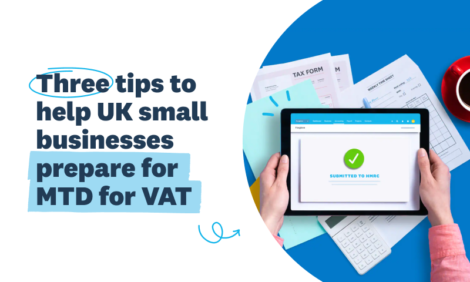
Three tips to help UK small businesses prepare for MTD for VAT

Not since a bespectacled wizard checked his mail has there been so much excitement around the arrival of post. The next phase of Making Tax Digital (MTD) is underway, with HMRC soon distributing letters to all businesses that will be affected.
This means that from April 2022, if you’re a business owner who charges VAT and has revenue under £85k, you’ll need to comply with HMRC’s digital tax legislation. Those still submitting paper-based records will have to maintain records online, filing VAT returns digitally.
Before the letters arrive, here are three handy tips to help you prepare.
1. Speak to your accountant or bookkeeper
Over the past 18 months or so, many small businesses have realised the vital role their accountants and bookkeepers play in ensuring their ongoing success. Xero research found that almost half (45%) of small businesses believe their advisor is more important to them than ever.
Chances are, they’ve already thought about how they are going to implement the necessary changes for you in time for April.
From offering practical advice on how to best digitise documents, to much-needed moral support, accountants and bookkeepers have the knowledge and the nous to drive you forward.
2. Check out resources
There is a lot of information available to get you up to speed on MTD. So where do you start?
First, why not check out our one-stop shop for understanding MTD? Tackling everything from important deadlines, to how you can become compliant, there’s no better place to start.
HMRC’s own MTD for VAT page also provides a wealth of useful insights – helping you find out whether your business applies, how you can sign up, and much more.
Finally, it’s important to remember that HMRC only accepts VAT returns sent using software that supports MTD. Here you can find a supplier to get you underway.
3. Make the most of digital
By adopting digital tools to help run your business, you can achieve a wealth of benefits, from speeding up processes to better managing finances.
But how exactly will digital tools play a part in MTD for VAT? HMRC will ask for a number of digital records to be kept – such as business name, adjustments to returns, rate of VAT charged on supplies made, and more.
While you can use spreadsheets to calculate or summarise VAT transactions and work out what information you need to send to HMRC, you’ll need to use compatible software to actually send it.
The right software, however, will make this painless – seamlessly pulling information from your digital records to submit returns. That way, you can save time that can be better spent running your business.
As for the next steps on your digitisation journey, why not consider signing up to the government’s scheme, Help to Grow? From December 2021, if your business is eligible, as well as getting access to free, impartial online support about how digital technology can help, you can also get a discount of up to 50% towards the costs of buying software.
How Xero can help
If you charge VAT and your revenue is under £85k, Xero can help you master your finances to achieve a healthy, MTD-compliant business. In fact, based on a recent Xero survey, 88% of respondents agreed that Xero has made MTD for VAT easy for them*.
Discover more about how Xero can help you ditch the spreadsheets, ensure you’re MTD-compliant, and ultimately help you spend less time on VAT.
*Based on an independent survey commissioned by Xero in the UK during August 2021 of 389 Xero subscribers.
The post Three tips to help UK small businesses prepare for MTD for VAT appeared first on Xero Blog.
Source: Xero Blog






